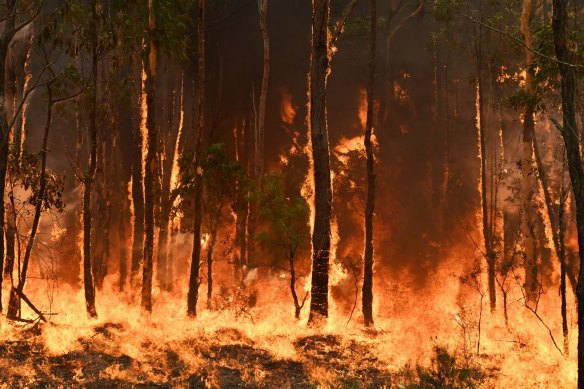Ensuring Bush Fire Security With Appropriate BAL Record Analysis
In the realm of bush fire security, the precise evaluation of Bushfire Attack Degree (BAL) reports stands as a keystone for protecting residential or commercial properties versus the disastrous effect of wildfires. With ecological factors and property attributes playing significant functions in determining the degree of risk, an extensive understanding of BAL rankings comes to be important.
Comprehending Bushfire Strike Level (BAL)
In the world of bushfire protection, comprehending the Bushfire Assault Degree (BAL) is paramount for guaranteeing effective mitigation methods. BAL is a system made use of to measure the potential risk a building might encounter from a bushfire. It thinks about variables such as the kind of vegetation, the slope of the land, the Fire Risk Index, and the Fire Intensity Index. Recognizing the BAL ranking of a property is essential for residential property proprietors, home builders, and policymakers to apply suitable actions to secure against bushfire hazards.

Significance of BAL Report Analysis
A necessary element in bushfire security planning involves the comprehensive analysis of BAL records to analyze the prospective dangers and identify proper mitigation techniques. BAL reports provide essential information about the possible influence of bushfires on a property based upon different aspects such as greenery type, distance to possible fire dangers, and slope of the land. Evaluating these reports with accuracy is vital in establishing reliable bushfire defense steps tailored to the details threat profile of a home.
Executing Fire Protection Actions
Applying effective fire protection actions is important for protecting residential or commercial properties in bushfire-prone locations. One of the main ways to improve fire protection is by developing defensible room around buildings. This entails cleaning flammable plants, such as dry fallen leaves and branches, within a specific distance of the home. In addition, mounting fire-resistant roof covering materials can help in reducing the danger of embers sparking the roofing during a bushfire. Effectively kept displays and gutters are likewise necessary to avoid particles build-up that could fuel a fire.
Furthermore, having a ample and well-kept water supply, such as a container or pool, can aid firemens in their initiatives to safeguard the home. BAL Report. In general, applying a combination of these fire protection actions can dramatically boost the chances of securing residential or commercial properties throughout bushfire events.
Mitigating Dangers in Fire-Prone Locations
To fortify buildings against bushfire dangers, a strategic emphasis on mitigating risks in fire-prone areas is important. Mitigating dangers in fire-prone locations involves a detailed strategy that encompasses different actions to reduce the probability and influence of bushfires. One essential element of threat reduction is maintaining defensible space around residential properties weblink by getting rid of flammable greenery, making sure ample spacing in between structures and trees, and utilizing fireproof landscape design practices. Additionally, carrying out ember-proofing actions such as installing metal mesh screens on windows and covering roof dental caries can help prevent cinder assaults and lessen the threat of place fires.
In addition, building or retrofitting buildings with fire-resistant materials and ensuring correct maintenance of roofing systems, gutters, and exterior cladding can substantially improve the building's durability to bushfires. Practicing a bushfire and establishing emergency plan with all occupants, consisting of evacuation treatments and communication strategies, is additionally important in mitigating threats successfully. By adopting a positive strategy to take the chance of mitigation in fire-prone locations, residential property owners can much better protect their properties and enhance general bushfire preparedness.
Ensuring Residential Or Commercial Property Safety and Durability
Ensuring the security and resilience of residential or commercial properties in fire-prone locations requires an unfaltering dedication to robust precautionary actions and tactical preparation. Residential property safety begins with carrying out reliable steps to minimize fire hazards. This consists of keeping a defensible space around the residential property by clearing combustible plant life, guaranteeing appropriate upkeep of roofings and seamless gutters, and utilizing fireproof structure products. Regular maintenance of firefighting tools, such as hoses and automatic sprinkler, is likewise critical to residential or commercial property durability.
Resilience, on the other hand, involves the capability of a residential or commercial property to recuperate and withstand from a bushfire. This can be enhanced via the installment of ash guards on home windows and vents, guaranteeing that entry factors for coal are decreased. In addition, having a well-thought-out evacuation strategy and exercising it consistently can significantly raise building strength. Teaming up with neighbors and local fire view authorities can additionally boost the security and resilience of properties in fire-prone locations. By proactively addressing these facets, homeowner can much better secure their assets and enjoyed ones from the risk of bushfires.
Final Thought
Finally, ensuring bushfire security via appropriate BAL record analysis is vital for understanding the level of danger posed by bushfires and executing essential fire protection steps. By minimizing risks in fire-prone areas and ensuring property safety and durability, people and areas can better get ready for and react to bushfire events. It is critical to prioritize fire security measures to secure lives and property in these high-risk environments.
In the realm of bush fire security, the careful evaluation of Bushfire Strike Degree (BAL) reports stands as a keystone for guarding residential or commercial properties versus the terrible effect of wildfires (BAL Report). Recognizing the BAL ranking of a building is essential for residential or commercial property contractors, policymakers, and owners to apply ideal actions to secure against bushfire risks

BAL reports offer vital details about the prospective effect of bushfires on a building based on various aspects such as plant life kind, range to potential fire risks, and slope of the land (BAL Report). Generally, applying a mix of recommended you read these fire protection measures can considerably enhance the possibilities of protecting residential properties throughout bushfire events